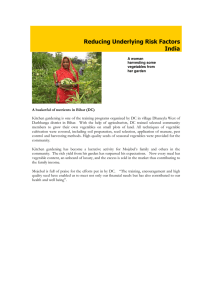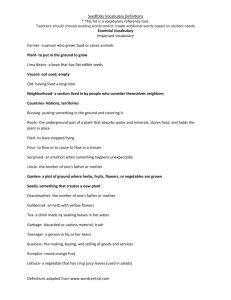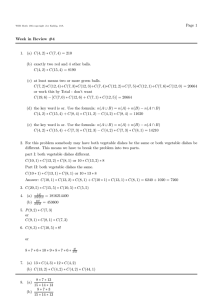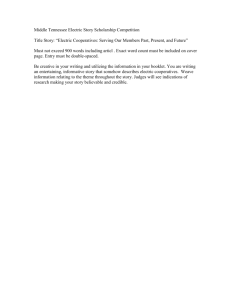Advance Journal of Food Science and Technology 4(6): 436-441, 2012
advertisement
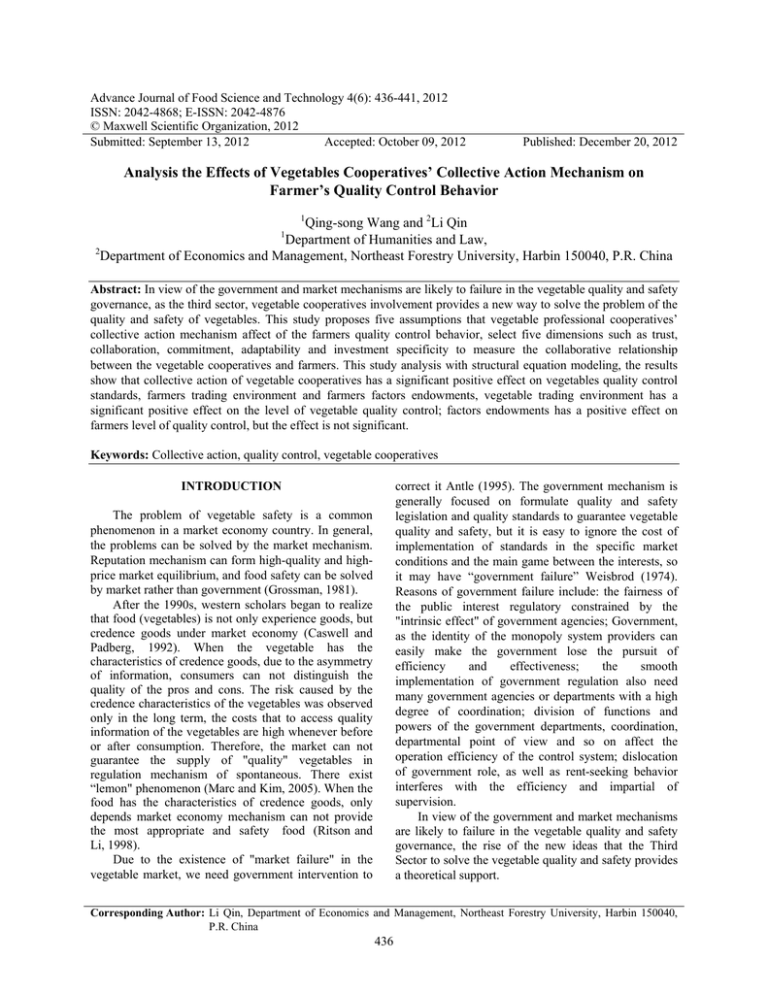
Advance Journal of Food Science and Technology 4(6): 436-441, 2012 ISSN: 2042-4868; E-ISSN: 2042-4876 © Maxwell Scientific Organization, 2012 Submitted: September 13, 2012 Accepted: October 09, 2012 Published: December 20, 2012 Analysis the Effects of Vegetables Cooperatives’ Collective Action Mechanism on Farmer’s Quality Control Behavior 1 Qing-song Wang and 2Li Qin Department of Humanities and Law, 2 Department of Economics and Management, Northeast Forestry University, Harbin 150040, P.R. China 1 Abstract: In view of the government and market mechanisms are likely to failure in the vegetable quality and safety governance, as the third sector, vegetable cooperatives involvement provides a new way to solve the problem of the quality and safety of vegetables. This study proposes five assumptions that vegetable professional cooperatives’ collective action mechanism affect of the farmers quality control behavior, select five dimensions such as trust, collaboration, commitment, adaptability and investment specificity to measure the collaborative relationship between the vegetable cooperatives and farmers. This study analysis with structural equation modeling, the results show that collective action of vegetable cooperatives has a significant positive effect on vegetables quality control standards, farmers trading environment and farmers factors endowments, vegetable trading environment has a significant positive effect on the level of vegetable quality control; factors endowments has a positive effect on farmers level of quality control, but the effect is not significant. Keywords: Collective action, quality control, vegetable cooperatives correct it Antle (1995). The government mechanism is generally focused on formulate quality and safety legislation and quality standards to guarantee vegetable quality and safety, but it is easy to ignore the cost of implementation of standards in the specific market conditions and the main game between the interests, so it may have “government failure” Weisbrod (1974). Reasons of government failure include: the fairness of the public interest regulatory constrained by the "intrinsic effect" of government agencies; Government, as the identity of the monopoly system providers can easily make the government lose the pursuit of efficiency and effectiveness; the smooth implementation of government regulation also need many government agencies or departments with a high degree of coordination; division of functions and powers of the government departments, coordination, departmental point of view and so on affect the operation efficiency of the control system; dislocation of government role, as well as rent-seeking behavior interferes with the efficiency and impartial of supervision. In view of the government and market mechanisms are likely to failure in the vegetable quality and safety governance, the rise of the new ideas that the Third Sector to solve the vegetable quality and safety provides a theoretical support. INTRODUCTION The problem of vegetable safety is a common phenomenon in a market economy country. In general, the problems can be solved by the market mechanism. Reputation mechanism can form high-quality and highprice market equilibrium, and food safety can be solved by market rather than government (Grossman, 1981). After the 1990s, western scholars began to realize that food (vegetables) is not only experience goods, but credence goods under market economy (Caswell and Padberg, 1992). When the vegetable has the characteristics of credence goods, due to the asymmetry of information, consumers can not distinguish the quality of the pros and cons. The risk caused by the credence characteristics of the vegetables was observed only in the long term, the costs that to access quality information of the vegetables are high whenever before or after consumption. Therefore, the market can not guarantee the supply of "quality" vegetables in regulation mechanism of spontaneous. There exist “lemon" phenomenon (Marc and Kim, 2005). When the food has the characteristics of credence goods, only depends market economy mechanism can not provide the most appropriate and safety food (Ritson and Li, 1998). Due to the existence of "market failure" in the vegetable market, we need government intervention to Corresponding Author: Li Qin, Department of Economics and Management, Northeast Forestry University, Harbin 150040, P.R. China 436 Adv. J. Food Sci. Technol., 4(6): 436-441, 2012 Mcginnis (2000) pointed out that the government cannot become all-powerful government, should considered the third sector institutions such as industry associations, cooperative organizations, to responsible for maintaining order, to participate in the management and regulation of political, economic and social affairs. Cooperatives are one of the specific forms of the agriculture sector organization. A growing number of Western scholars recognize cooperatives as a coexistence of a special kind of institutional resources mechanism with market economy, the stock company system enterprise, it is the alternative choice to socially vulnerable in the field of market failures or government regulation is not completely effective. It is the third sector in social and economic development parallel with the public sector and private sector. Scholars study found that cooperatives have a major impact on product quality supply. For example, Herbst and Prufer (2007) constructed a non-profit organizations, partner organizations and the IOF's product quality and supply situation model, results show that product quality is the highest that supply by the non-profit organization, followed is cooperation organizations, the lowest supply level of the products quality from enterprise. Drivas and Giannakas (2010) applied game model analysis the investment decisionmaking and innovation behavior of co-operatives and IOF on enhance product quality, the results show that, the pursuit of the cooperatives of member welfare maximization are more willing to invest in quality improvement or quality innovation than IOF. Regardless of product quality differences in the market, no matter the market structure, the presence of co-operatives are able to bring about welfare improvements. Some scholars have studied cooperatives and the IOF product quality supply strategy from the perspective of quality competition (Saitone and Sexton, 2009). In the developed countries, co-operatives as the representative of social intermediary organizations play an important role in protection of agricultural products (vegetables), safety certification and protect the legitimate interests of enterprises. From the situation of our country, a large number of small-scale farmers can not ensure the quality and safety of the vegetables. To ensure vegetables’ quality and safety need to establish intermediary organizations. Farmers' professional cooperatives are not only united scattered small-scale farmers, but also on behalf of the farmers interests, so that ensure farmers interests and the quality and safety of vegetables. However, in china, researcher study on the cooperative of agricultural products behavior is relatively rare, and on the basis of the above study, the paper analysis the effect of collective action mechanism of cooperatives to vegetables quality and safety of agricultural products behavior. Currently in China, research is relatively scarce on the cooperative is how to affect the vegetable product quality safety behavior. On the basis of the above research, this article wills analysis the effects of vegetables cooperatives’ collective action mechanism on farmer’s quality control behavior. MODEL AND ASSUMPTION Collective action is based on certain beliefs, rules and order. Olson reveals "free rider" phenomenon is widespread within the group, it is the source that a collective with a common interest does not necessarily produce collective action. The common interests of the group is a public good, even if the members do not pay the cost can also reap the gains of the items. In order to overcome this "free rider" dilemma, Olson designed a mandatory and "selective incentives" organizational strategy. In vegetable cooperatives, their product quality and safety aspects of collective action is the cooperative behavior based on market mechanism, it is a concerted action under the rules of the game through the individual decision-making, product quality and safety reach a collective. From the current practice, vegetable cooperatives generally adopts the unified production, unified sale, unified normative behavior to standardize behavior of vegetable cooperatives and members bring consumers quality and safety products. For convenience, this study proposes the following assumptions: Assumption 1: Collective action of vegetable professional cooperatives has a positive impact on the vegetable quality and safety control behavior. From the point of the supply chain of agricultural products, the quality of agricultural products has a close relationship with farmers supply and marketing transaction. Through collective action mechanism, farmers and cooperatives formed a close collaborative approach. Through the conclusion of the contract, vegetable professional cooperatives can provide quality of preventive measures in advance and safe production technology support in the implementation of the vegetable production chain, and can implement the traceability system constraints vegetable production behavior, to achieve effective supervision and control. By the high price of high-quality, stable trading mechanism, vegetable professional cooperatives with the farmers form interests win-win situation, in order to obtain high gains farmers will be conscious control of product quality. Assumption 2: Collective action can improve farmers’ market trading environment. Farmers join the vegetable cooperatives can reduce their market risk, the simple purchase and sale 437 Adv. J. Food Sci. Technol., 4(6): 436-441, 2012 transaction by the contract likely to cause market failure and the opportunistic behavior of the producers. In this case, vegetables tend to fall into the trap of low-quality equilibrium. Vegetable and vegetable cooperatives to engage in collective action, to establish a close collaborative relationship between the two sides can make the cost of "high quality” vegetable productions achieve the higher prices. And agreed vegetables transaction price, quantity, time, quality in advance, and form a stable trading environment, reducing the market risk faced by the farmers produce high quality vegetables. Assumption 3: Vegetable trading environment has a positive impact on vegetable quality control acts. Improve the quality of the vegetables need farmers to enhance quality control in the vegetable production chain. Produce a high level of quality vegetables will increase farmers manage costs and technology costs, thus weakening the price competitiveness of the vegetable products in the market. If the cost in order to ensure the quality and safety of vegetables in the market are not recognized, high-quality vegetables could not sell a good price or difficult to sell out on the high price, the enthusiasm of farmers to produce high quality vegetables will be greatly weakened. Only a favorable market environment, through the supervision of the market order, limit the opportunistic behavior, combat poor vegetable products that can be effectively increase the enthusiasm of the farmers produce high quality products and enhance control strength of vegetable production and marketing quality and safety. Assumption 4: Collective action of vegetable cooperatives can improve the endowment of factors of production of vegetables. In market economy, the behaviors of market players are to maximize their own interests. The important purpose of farmers join the vegetable cooperatives is formed their factor endowments complementary. Collective action of vegetable cooperatives, the land owned by farmers, production, production technology and experience can make up the vegetable cooperatives directly to master the elements of the vegetable production. Vegetable cooperatives can effectively compensate for the funds in the vegetable business process the lack of backward technology, inadequate, both sides realized complementary cooperation. Assumption 5: Vegetable production factor endowments significant impact on the farmers, vegetable quality and safety control behaviors. Vegetable production, especially pollution-free vegetables have the characteristics of production Fig. 1: Research model and assumptions technology and high capital investment. In vegetable production and marketing stage, to control the quality of the vegetables, the farmers not only need to study the basic vegetable production habits, master the scientific plant protection, cultivation techniques, scientific medicine and rational fertilization, also need to increase investment in green technology and equipment, such as vegetable cleaning, packaging, preservation techniques and equipment inputs. Therefore, the production of high-quality vegetables need to put in more technology and capital costs. If vegetable growers not mastered sufficient and complete production factor endowments, vegetable quality control behavior will be greatly limited. The research model is shown in Fig. 1. VARIABLES AND STATISTICAL METHODS Variable design: Collective action of vegetable cooperatives can form a close collaborative relationship between the farmers and vegetable cooperatives. Summarize previous studies, the variables used to measure the relationship between the main body of the collaboration: collaborative exchange between subjects, interdependence, commitment, adaptability, collaboration, trust, investment specificity, environmental dynamic, information sharing, partner matching, the relationship governance, joint planning, joint problem-solving, formal governance indicators (Cheng-lin et al., 2008). In this study, select the highest frequency dimensions of trust, collaboration, commitment, adaptability, and investment specificity to measure the collaborative relationship between the vegetable cooperatives and farmers. Trust is that the parties believe the other side all the acts to be mutually beneficial. Commitment is a continuing intent to maintain the important relationship between the two sides. Adaptability means the two sides can adapt well to each other’s special needs. Collaboration means the two sides in order to achieve a common goal and work 438 Adv. J. Food Sci. Technol., 4(6): 436-441, 2012 together (Cheng-lin et al., 2008). Investment specificity refers to the durability of investment to support a particular transaction. In addition, vegetable trading environment, vegetable production factor endowments as well as farmers level of quality control measure, there are no more recognized uniform standards. Because of their different emphases, the indicators used to measure or standard on the differences research are different. Here, we use farmers personal and family characteristics, production characteristics, longitudinal collaborate, vegetable trading environment, vegetable production factors endowment, farmers pesticide application behavior, fertilizer behavior and vegetable postharvest handling behavior to measure the quality of the vegetable growers. A measure of the above variables maximize use of already existing literature measuring scale , such as vegetable trading environment, vegetable production factors endowment and vegetable growers level of quality control are mainly reference (Jie-hong and Li-qing, 2007; Hua-yong and Kai, 2007) . Measurement scale combined with the object of study made some modifications. Before conducting a formal investigation, we pre-survey of farmers and combined with actual perfected our survey questionnaire. Most of the topics in questionnaire using Likert scale form. Statistical analysis method: In this study, we established structural equation modeling method to analysis. The specific operation is on Amos 7.0 analysis software. In the specific analysis of the process, we must first use Confirmatory Factor Analysis (CFA) to test the measurement model and then test the structural model. Structural equation model fit the situation can measure by the relevant index. There are a variety of indices used to evaluate the structural equation model fitting situation, commonly used are: x2/df, Adjusted Goodness Fit Index (AGFI), Goodness Fit Index (GFI), Comparative Fit Index (CFI), Norms Fit Index (NFI) and the approximation error of the Root-Mean-Square (RMSEA). x2/df (1, 3), indicating that the model goodness of fit within an acceptable range. AGFI, GFI, CFI and NFI range of the four indices above 0.9, it indicates that the goodness of fit of the model is ideal. If the four indices range (0.8, 0.9), it shows that the goodness of fit of the model within an acceptable range. The RMSEA index range (0, 1) is used to measure and estimate the consistency of the covariance for each degree of freedom, the lower the value of the index, the higher the model goodness of fit. General, if the RMSEA index value is smaller than 0.05, indicating that the model goodness of fit is better, lower than 0.08, indicating that the model goodness of fit within an acceptable range. DATA ANALYSIS, RESULTS AND DISCUSSION The validity and reliability analysis: First, use confirmatory factor test of validity and reliability of the measurement scale of the relevant variables. Thirteen measurements in four structural variables included in the structural equation model. Specific reliability and validity test structure is shown in Table 1. Cronbach a measure we use to test measuring the amount of internal consistency reliability. Table 1 results shows that a value of 0.73, 0.75, 0.73 and 0.72, respectively, more than 0.71 means that the internal reliability of the measurement scale in the acceptable range. In addition, the use of the factor loadings to examine the convergent validity of the scale , the analysis showed that all factor loading values t are greater than 2.0, and that all factor loadings were significant. And composite reliability values close to or greater than an acceptable 0.71. Therefore, the ideal measurement scale convergent validity and convergent validity of measurement scale is ideal. STRUCTURAL EQUATION MODELING ANALYSIS AND CONCLUSION Based on the above, we use confirmatory factor analysis to test the goodness of fit the total measurement model, the model excellent index analysis results shown in Table 2, which, X2/df = 1.987, (1, 3), the acceptable range: CFI = 0.922; NFI = 0.821; AGFI = 0.892; RMSEA = 0.071, which is less than 0.08, the measurement model fit goodness as a whole is acceptable. After using the CFA to verify the measurement model, use Amos 7.0 analysis of the model, results shown in Table 2: 439 The collective action of vegetable cooperatives has a significant positive effect on vegetables quality control standards ( = 0.22, p<0.05), and the impact is positive, assumption 1 be verified. Strengthen the cooperation of the farmers and vegetable professional cooperatives, actively participate in the collective action of cooperatives, and help strengthen the level of quality and safety control of the farmers. The collective action of the vegetable cooperatives has a significant positive effect on farmers trading environment ( = 0.24, p<0.05), and the impact is positive, assumption 2 be verified. Farmers participate in the collective action of vegetable cooperatives will help to reduce the vegetable farmers market trading risk, and promote the stability of the transaction, achieve the market value of high-quality vegetables. Vegetable trading environment has a significant positive effect on the level of vegetable quality control ( = 0.27, p <0.05), assumption 3 be verified. Improve the stability of the vegetable Adv. J. Food Sci. Technol., 4(6): 436-441, 2012 Table 1: Measurement model analysis results Structure variables Measurement items Cronbach a Vegetable 0.73 Trust: The members and the cooperative feel that cooperatives and we can fully trust each other member relations Collaboration: Member and co-operatives work closely in product quality control Commitment: Members and the cooperative can long-term maintenance of product quality and cooperative relations Adaptability: To meet the safety requirements, members adjust the mode of production Dedicated inputs: If the termination of cooperation, members and co-operatives will suffer losses Transaction 0.75 Difficulty degree of quality has been recognized environment payment Stability of the vegetable trading partners Vegetables quality supervision intensity Factor 0.73 Difficulty degree of financial support in safe endowments vegetable production Difficulty degree of technical support in safe vegetable production Quality control 0.72 Farmers pesticide application behavior Farmers fertilizer applied behavior Farmers vegetable postharvest handling behavior CFA model x2/df = 1.987; CFI = 0.922; NFI = 0.821; AGFI = 0.892; RMSEA = 0.071 goodness index Table 2: Structural equation model analysis results Assumption Structural model path H1 Cooperative quality control level H2 Cooperative trading environment H3 Trading environment level of quality control H4 Cooperative factor endowments H5 Factor endowments level of quality control p*: p<0.05 trading partners; approved payment difficulty of the quality of the vegetables is reducing, and the supervision intensity enhancement of the quality of the vegetables, which help to improve the level of quality and safety control of vegetable farmers. Collective action of vegetable cooperatives has a significant positive effect on farmers factors endowments ( = 0.43, p<0.05), assumption 4 be verified. It is description that the collective action of vegetable cooperatives will help to improve the vegetable farmers to obtain capital and technology. Factors endowments has a positive effect on farmers level of quality control, but the effect is not significant ( = 0.12, p>0.05), assumption 5 has not been verified. It shows that improve narrow channels of farmers obtain technical and financial has a positive impact on the level of quality control of vegetables and agricultural, but this effect was not significant. In reality, funding and technology access more excellent farmers, vegetable quality and safety control level effect is not necessarily like. For example, a high degree of farmer’s bybusiness, the income and technical level are optimum. But because of focus on income, in the Composite reliability 0.76 Factor loadings 0.70 T 7.97 0.65 8.24 0.52 7.90 0.70 9.31 0.76 9.46 0.51 7.97 0.73 0.70 0.72 0.62 9.26 8.31 7.98 0.71 0.70 9.88 0.75 0.61 0.66 10.16 7.910 8.820 Path coefficient 0.24* 0.27* 0.24* 0.43* 0.12* 0.72 Test results Support Support Support Support Not support case of market failure, opportunistic behavior more often and the quality vegetable production is not high. The necessary condition of high level of quality and safety control is have certain financial and technical support, the traditional mode of small farmers production, vegetable farmers lack the capital and technology, it is difficult to protect the quality of the vegetables. In short, the farmers joined vegetable professional cooperatives and abide by the collective action plan will improve the farmers vegetable quality control level. Collaboration with cooperatives, cooperatives provides technical guidance and detects the acquisition of vegetables, so in collaboration with the cooperative, the farmers level of quality control improve active or passive. ACKNOWLEDGMENT The authors thank the Fundamental Research Funds for the Central Universities (DL11CC12); the National Social Science Fund (11BJY101); the 2010year Philosophy and Social science Foundation of Heilongjiang (10C002) for support. 440 Adv. J. Food Sci. Technol., 4(6): 436-441, 2012 REFERENCES Antle, J.M., 1995. Choice and Efficiency in Food Safety Policy. The AEI Press, Washington. DC, pp: 48-56. Caswell, J.A. and D.I. Padberg, 1992. Toward a more comprehensive theory of food labels. Am. J. Agric. Econ., 74: 460-468. Cheng-lin, L., Q. Ming-quan and L. Yong, 2008. An empirical study on the relationship among collaborative relationship, agile supply chain and business performance. Syst. Eng. Theory Prac., 6: 116-125. Drivas, K. and K. Giannakas, 2010. The effect of cooperatives on quality-enhancing innovation. J. Agric. Econ., 2: 295-317. Grossman, S.J., 1981. The information role of warranties and private disclosure about product quality. Law Econ., 24: 461-483. Herbst, P. and J. Prufer, 2007. Firms, Nonprofits and Cooperatives: A Theory of Organizational Choice. Working Paper, Retrieved from: http:// ideas. repec. org/p/dgr/kubtil/2007003.html. Hua-yong, D. and W. Kai, 2007. The impact of agrichain management on performance of quality and safety. J. Nanjing Agric. Univ. Soc. Sci., 1: 43-47. Jie-hong, Z. and J. Li-qing, 2007. An analysis on vegetable farmers’behaviors and the food safety system. J. Zhejiang University Human. Soc. Sci., 1: 118-127. Marc, T. and S. Kim, 2005. Specialization and regulation: The rise of professionals and the emergence of occupational licensing regulation. J. Econ. History, 65: 723-756. Mcginnis, M., 2000. Polycentricity and Local Public Economies: Readings from the Workshop in Political Theory and Policy Analysis. University of Michigan Press, Ann Arbor, pp: 424, ISBN: 0472086227. Ritson, C. and W.M. Li, 1998. The economics of food safety. Nutrit. Food Sci., 5: 253-259. Saitone, T.L. and R.J. Sexton, 2009. Optimal cooperative pooling in a quality-differentiated market. Am. J. Agric. Econ., 91(5): 1224-1232. Weisbrod, B., 1974. Toward a Theory of the Voluntary Nonprofit Sector in Three-Sector Economy. In: Phelps, E. (Ed.), Altruism Morality and Economic Theory. Russel Sage, New York. 441
